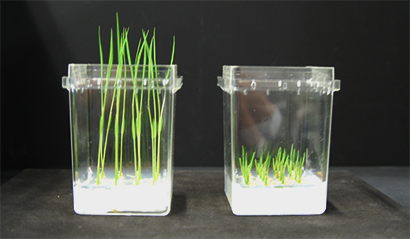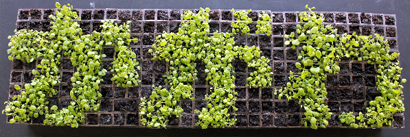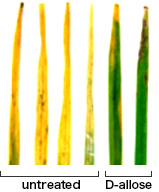ここから本文です。
Rare Sugar’s Use with Plant Life
Kagawa University' s Faculty of Agriculture' s ongoing research into rare sugar's effects on plantshas yielded some interesting results. D-allulose has been found to be suitable as ameans of adjusting the rate of plant growth, and effective in improving resistances to disease.

Kagawa University Faculty of Agriculture’s
Rare Sugar's Ability to Modulate Plant Growth
It has been confirmed that rare sugars such as D-allulose and D-allose can be used to modify the growth of plants like rice, thale cress (Arabidopsis thaliana), birdsfoot trefoil (Lotus japonicus), tomatoes, and so on. Interestingly enough, this has been shown to be a transient effect. When use of the rare sugar on the plant life is halted, the effects also cease, and the plant life returns to its normal rate of growth.

The rice on the right has received a liquid solution of D-allulose. When compared to the rice on the left that has not received the D-allulose solution, it is easy to see that the rate of growth has been suppressed. This feature of rare sugar has a number of possible applications. It could, for example, be used on a golf course to manage the grass (controlling the length and allowing for easier maintenance).

Or,if a part of a plant is not growing, D-allulose can be applied to it to temporarily suspend growth altogether,and when application of D-allulose is halted, normal growth will resume.





Rare Sugar's Ability to Guard Against Disease
If a low concentration of D-allulose or D-allose is sprayed on a plant’s leaves, or it is absorbed through the roots, a disease resistant gene is induced within the plant, and it will have stronger resistances against various kinds of disease.
 From the left, leaves 1 to 4 are untreated rice plant leaves exposed to bacterial leaf blight fungus. The disease has spread through them, and they have withered. On the other hand, leaves 1 and 2 on the right have been treated with D-allose before being exposed to the bacterial leaf blight fungus. The spread of the disease in those leaves has been suppressed.
From the left, leaves 1 to 4 are untreated rice plant leaves exposed to bacterial leaf blight fungus. The disease has spread through them, and they have withered. On the other hand, leaves 1 and 2 on the right have been treated with D-allose before being exposed to the bacterial leaf blight fungus. The spread of the disease in those leaves has been suppressed.
※Bacterial leaf blight is a disease in rice plants that causes the leaves to wither and die, going from yellow and white to ashen colored.
このページに関するお問い合わせ